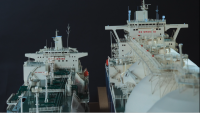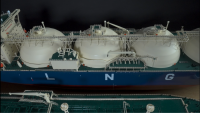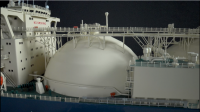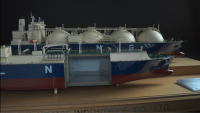Maritime Innovation In Miniature
The LNG Models: A Green Solution
"The Lloyds Register Foundation have in their collection a number of significant ship models that highlight key moments in changing maritime technology. One of the finest models is a pair of Liquified Natural Gas (LNG) carriers presented to Lloyd's Register in 1999 by the shipbuilders Hyundai Heavy Industries of South Korea. One is of the Hyundai Technopia and the other is a concept ship – demonstrating the ability of Hyundai Heavy Industries to construct LNG carriers of different designs.
The model usually stands in the reception area of the Lloyds Register Foundation’s magnificent home offices in Fenchurch Street, London. For the filming, the model was moved to the current, temporary home of the Lloyds Register Foundation archive at Cannon House in Woolwich. This gave us an excellent space to work in, where there was room to move around the model and control the lighting.
Not only was this a good practical location but also an interesting one: Cannon House is itself an important historical building, set in an important historic area of London - Woolwich Arsenal. This is where the British government designed, manufactured, tested and stored its ordnance for over four centuries.
The LNG models were an important place to start this project for a number of reasons. Although ship models have a very long history (the oldest one in Europe is the Mataró, a fifteenth century model in the Maritime Museum Rotterdam) these models serve as an important bridge between past and present and shine a light on a key moment in the history of maritime technology, the history of the use and movement of energy, and the ongoing history of humanity’s transition away from fossil fuels. One of the two models – the Hyundai Technopia – is currently operational. As I write it is currently heading east out of the Singapore Strait, travelling at 18 knots. It’s last port of call was Ras Laffan in Quatar and she is heading to Anjeong in Korea.
The models represent two different design solutions to the problem of how to move Liquefied Natural Gas (LNG) by sea. It was an important problem to solve: LNG is a fossil fuel but a relatively green and clean one and therefore is playing a crucially important role as we transition towards a carbon-free future. It is non-toxic, non-corrosive, non-flammable, non-explosive, odourless and colourless – and, if spilled, causes no damage to the marine environment. If liquified, the volume of the gas is also reduced by 600 times making its transportation incredibly efficient. The challenge, however, lay in how to store it as it must be stored at atmospheric pressure, but at -163 degrees Celsius. Two design solutions are shown in these models, the Moss Spherical type and the membrane type, both developed in the early 1960s and here shown with the designs streamlined and refined in the 1990s. The Hyundai Technopia was the fourth LNG carrier built by Hyundai Heavy Industries. These designs solutions have been little changed since and have been used to successfully transport LNG around the globe.
These models are also particularly well suited to being filmed in extreme close-up because of the high quality of the construction but also because of the curious architecture of the vessels. The white spheres of the Hyundai Technopia in particular, when filmed with the macro probe lens, appeared almost surreal. We all commented on how the vessel looked like something out of Star Wars – the domes appearing ethereal against a black background as the lens glided past. Two hours of setting up and more than four hours of filming has captured these vessels in a remarkable way, and all made possible by the enthusiasm and help of the curatorial team at the Lloyds Register Foundation." - Dr Sam Willis





Additonal resources on LR's current work on LNG carriers.
-
Helping build the sustainable future of gas
For over 60 years, LR has been at the forefront of the industry helping the transportation of liquid gas to become more economical, safer and more efficient.
-
Maritime Decarbonisation Hub
Creating safe, sustainable pathways to a zero-carbon maritime industry.
-
LR awards HHI Design Approval for world’s first 40,000cbm LCO2 carrier
LR has awarded Design Approval to South Korean shipbuilder Hyundai Heavy Industries (HHI) for the development of the world’s first 40,000m3 liquefied carbon dioxide carrier.
-
LR award AiP for HB Hunte’s new gas storage and supply system
LNG fuel storing and supply system designed for efficiency on smaller vessels.
-
LR awards Elcano AiP for LNG carrier steam-to-hybrid conversion design
The design will allow shipowners to convert steam powered vessels to hybrid dual-fuelled propulsion.
-
Why LNG is key to energy security
Why a ship supply crunch could worsen the world’s energy crisis and limit scope for LNG to support the energy transition.
-
World’s first LNG-fuelled bulk carrier delivered.
50,000 dwt LNG-fuelled bulk carrier uses new LNG storage material approved by LR.
-
Lloyd’s Register to Class First Dual Fuel LNG Carriers
Lloyd’s Register (LR) has signed the classification contract for six 174,000 m3 liquefied natural gas (LNG) tankers to be built by Hudong Zhonghua Shipbuilding (Group) Co. Ltd.

